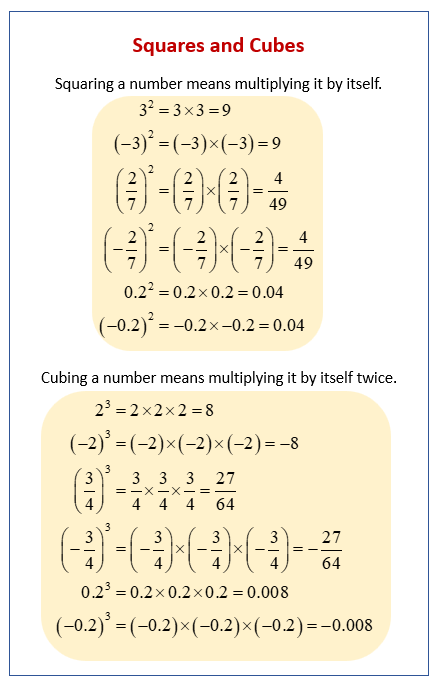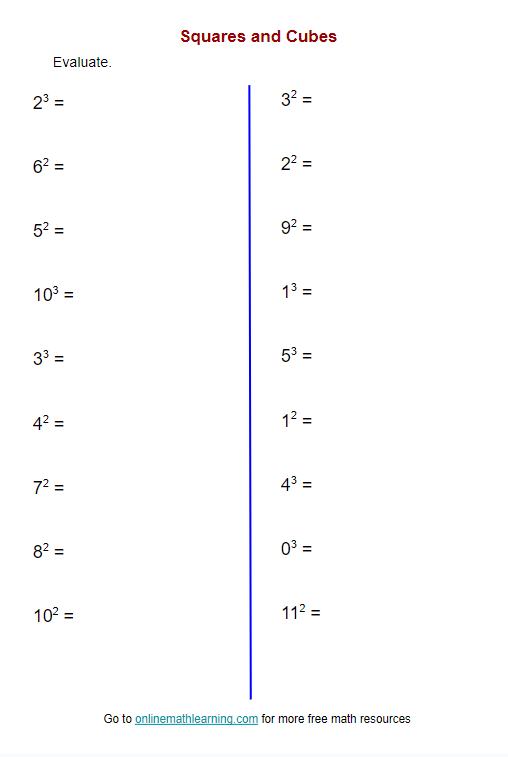Squares & Cubes Worksheet
Related Topics:
More Math Worksheets
More Grade 6 Math Lessons
Grade 6 Math Worksheets
There are five sets of exponents worksheets:
- Squares & cubes
- Whole number exponents
- Negative whole number exponents
- Unit fraction exponents (positive or negative)
- Fractional exponents (positive or negative)
Examples, solutions, videos, and worksheets to help Grade 6 students learn how to calculate squares and cubes of a number. The number, also called the base, can be a positive or negative whole number, a positive or negative fraction, a positive or negative decimal.
How to calculate squares and cubes of a number?
There are four sets of squares and cubes worksheets:
- Positive Whole Number Base
- Negative Whole Number Base
- Fractional Base (Positive or Negative)
- Decimal Base (Positive or Negative)
Exponents, also known as powers or indices, are mathematical expressions that represent repeated multiplication of a base number by itself. They are a shorthand way of writing large or small numbers.
In an exponent expression, the base number is raised to a certain power, which is indicated by a superscript or a raised number to the right of the base. The power represents the number of times the base is multiplied by itself.
For example, in the expression 23, the base is 2, and the power is 3. This means that 2 is multiplied by itself three times: 2 × 2 × 2 = 8. So, 23 equals 8.

Squares and cubes are special cases of exponents where the power is specifically 2 or 3, respectively.
Squares: When a number is raised to the power of 2, it is called a square. Squaring a number means multiplying it by itself. For example, 3 squared (written as 32) is 3 × 3 = 9. Similarly, (-2)2 is (-2) × (-2) = 4.
Squares have these properties:
- The square of a positive number is always positive.
- The square of a negative number is always positive.
- The square of 0 is 0.
- The square of a number greater than 1 is greater than the original number, while the square of a number between 0 and 1 is smaller than the original number.
Cubes: When a number is raised to the power of 3, it is called a cube. Cubing a number means multiplying it by itself twice. For example, 2 cubed (written as 23) is 2 × 2 × 2 = 8. Similarly, (-3)3 is (-3) × (-3) × (-3) = -27.
Cubes have these properties:
- The cube of a positive number remains positive.
- The cube of a negative number remains negative.
- The cube of 0 is 0.
- The cube of a number greater than 1 is greater than the original number, while the cube of a number between 0 and 1 is smaller than the original number.
Have a look at this video if you need to review how to calculate squares and cubes.
Click on the following worksheet to get a printable pdf document.
Scroll down the page for more Squares & Cubes Worksheets.
More Squares & Cubes Worksheets
Printable
(Answers on the second page.)
Squares & Cubes Worksheet #1 (Positive Whole Number Bases)
Squares & Cubes Worksheet #2 (Negative Whole Number Bases)
Squares & Cubes Worksheet #3 (Positive or Negative Fractional Bases)
Squares & Cubes Worksheet #4 (Positive or Negative Decimal Bases)
Generated
Squares with bases 0 to 10
Squares with bases 2 to 20
Squares with bases -10 to 0
Squares with bases -20 to 0
Cubes with bases 0 to 10
Cubes with bases 2 to 20
Cubes with bases -10 to 0
Cubes with bases -20 to 0
Related Lessons & Worksheets
Try the free Mathway calculator and
problem solver below to practice various math topics. Try the given examples, or type in your own
problem and check your answer with the step-by-step explanations.

We welcome your feedback, comments and questions about this site or page. Please submit your feedback or enquiries via our Feedback page.
